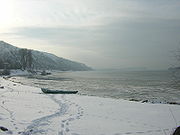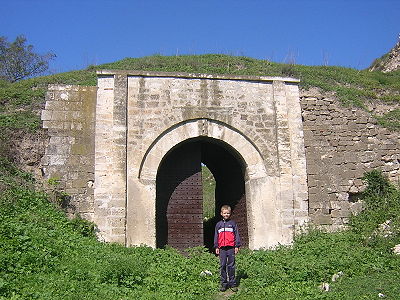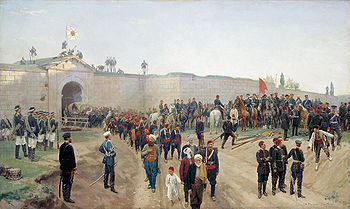
Nikopol, Bulgaria
Encyclopedia


Bulgaria
Bulgaria , officially the Republic of Bulgaria , is a parliamentary democracy within a unitary constitutional republic in Southeast Europe. The country borders Romania to the north, Serbia and Macedonia to the west, Greece and Turkey to the south, as well as the Black Sea to the east...
, the administrative center of Nikopol municipality
Nikopol Municipality
Nikopol Municipality is a municipality in the northern part of Pleven Province, in northern Bulgaria. It is named after its administrative centre - the town of Nikopol. The municipality embraces a territory of with a population, as of December 2009, of 10,602 inhabitants.Its northern border is...
, part of Pleven Province
Pleven Province
Pleven Province is a province located in central northern Bulgaria, bordering the Danube river, Romania and the Bulgarian provinces of Vratsa, Veliko Tarnovo and Lovech. It is divided into 11 subdivisions, called municipalities, that embrace a territory of 4,333.54 km² with a population, as...
, on the right bank of the Danube
Danube
The Danube is a river in the Central Europe and the Europe's second longest river after the Volga. It is classified as an international waterway....
river, 4 km downstream from the mouth of the Osam
Osam
The Osam is a river in northern Bulgaria. Its drainage basin is in between that of the river Vit to the west and the Yantra system to the east. The river has two main tributaries in its upper course: the Black Osam takes its source from the foot of Levski Peak in the Balkan Mountains, at an...
river. It spreads at the foot of steep chalk cliffs along the Danube and up a narrow valley. As of December 2009, the town has a population of 3,892 inhabitants.
History
In Roman timesAncient Rome
Ancient Rome was a thriving civilization that grew on the Italian Peninsula as early as the 8th century BC. Located along the Mediterranean Sea and centered on the city of Rome, it expanded to one of the largest empires in the ancient world....
, it was a village in the province of Moesia
Moesia
Moesia was an ancient region and later Roman province situated in the Balkans, along the south bank of the Danube River. It included territories of modern-day Southern Serbia , Northern Republic of Macedonia, Northern Bulgaria, Romanian Dobrudja, Southern Moldova, and Budjak .-History:In ancient...
, first mentioned in 169. After the decline of the Roman Empire
Roman Empire
The Roman Empire was the post-Republican period of the ancient Roman civilization, characterised by an autocratic form of government and large territorial holdings in Europe and around the Mediterranean....
, the town turned out to be located at the northern border of the Byzantine Empire
Byzantine Empire
The Byzantine Empire was the Eastern Roman Empire during the periods of Late Antiquity and the Middle Ages, centred on the capital of Constantinople. Known simply as the Roman Empire or Romania to its inhabitants and neighbours, the Empire was the direct continuation of the Ancient Roman State...
. In 1059, it was named Nicopolis, Greek
Greek language
Greek is an independent branch of the Indo-European family of languages. Native to the southern Balkans, it has the longest documented history of any Indo-European language, spanning 34 centuries of written records. Its writing system has been the Greek alphabet for the majority of its history;...
for "City of Victory". During most of the Middle Ages, it was part of the Bulgarian Empire
Bulgarian Empire
Bulgarian Empire is a term used to describe two periods in the medieval history of Bulgaria, during which it acted as a key regional power in Europe in general and in Southeastern Europe in particular, rivalling Byzantium...
. After the fall of Tarnovo
Siege of Tarnovo
The siege of Tarnovo occurred in the spring of 1393 and resulted in a decisive Ottoman victory. With the fall of its capital, the Bulgarian Empire was reduced down to a few fortresses along the Danube.- Origins of the conflict :...
in 1393, the last Bulgarian Tsar Ivan Shishman
Ivan Shishman of Bulgaria
Ivan Shishman ruled as emperor of Bulgaria in Tarnovo from 1371 to 3 July 1395. The authority of Ivan Shishman was limited to the central parts of the Bulgarian Empire. His indecisive and inconsistent policy did little to prevent the fall of his country under Ottoman rule. In 1393 the Ottoman...
defended what remained of the Empire from the fortress of Nikopol, where he was captured after the town was conquered by the Ottomans in 1395. Nikopol is therefore sometimes considered the capital of Bulgaria during these two years. It was the site of the Battle of Nicopolis
Battle of Nicopolis
The Battle of Nicopolis took place on 25 September 1396 and resulted in the rout of an allied army of Hungarian, Wallachian, French, Burgundian, German and assorted troops at the hands of an Ottoman force, raising of the siege of the Danubian fortress of Nicopolis and leading to the end of the...
, the last large-scale crusade of the Middle Ages, in 1396. At the fortress of Nicopolis, the united armies of Christian Europe headed by Hungarian
Kingdom of Hungary
The Kingdom of Hungary comprised present-day Hungary, Slovakia and Croatia , Transylvania , Carpatho Ruthenia , Vojvodina , Burgenland , and other smaller territories surrounding present-day Hungary's borders...
king Sigismund
Sigismund, Holy Roman Emperor
Sigismund of Luxemburg KG was King of Hungary, of Croatia from 1387 to 1437, of Bohemia from 1419, and Holy Roman Emperor for four years from 1433 until 1437, the last Emperor of the House of Luxemburg. He was also King of Italy from 1431, and of Germany from 1411...
and various French
Kingdom of France
The Kingdom of France was one of the most powerful states to exist in Europe during the second millennium.It originated from the Western portion of the Frankish empire, and consolidated significant power and influence over the next thousand years. Louis XIV, also known as the Sun King, developed a...
kinghts were defeated by the Ottomans under Bayezid I
Bayezid I
Bayezid I was the Sultan of the Ottoman Empire, from 1389 to 1402. He was the son of Murad I and Valide Sultan Gülçiçek Hatun.-Biography:Bayezid was born in Edirne and spent his youth in Bursa, where he received a high-level education...
and his Serbian
Serbian Despotate
The Serbian Despotate was a Serbian state, the last to be conquered by the Ottoman Empire. Although the Battle of Kosovo in 1389 is generally considered the end of the medieval Serbian state, the Despotate, a successor of the Serbian Empire and Moravian Serbia survived for 70 more years,...
ally Stefan Lazarević
Stefan Lazarevic
Stefan Lazarević known also as Stevan the Tall was a Serbian Despot, ruler of the Serbian Despotate between 1389 and 1427. He was the son and heir to Prince Lazar, who died at the Battle of Kosovo against the Turks in 1389, and Princess Milica from the subordinate branch of the Nemanjić dynasty...
.
Under Ottoman rule, Nikopol developed into an important military and administrative centre as sanjak, with a strong fortress and a flourishing economic, spiritual and political life, until it went into a decline during the 17th and 18th centuries. It was the centre of a district (kaza), but it was overtaken by Pleven
Pleven
Pleven is the seventh most populous city in Bulgaria. Located in the northern part of the country, it is the administrative centre of Pleven Province, as well as of the subordinate Pleven municipality...
as the regional centre of that part of the Bulgarian lands. Nikopol was captured by the Russians in the Battle of Nikopol
Battle of Nikopol
The Battle of Nikopol, or Nicopolis, was one of the early battles of the Russo-Turkish War . As the Russian army crossed the Danube River, they approached the fortified city of Nikopol . The Turkish high command sent Osman Pasha with the troops from Vidin to oppose the Russians' crossing of the...
in 1877.
The Roman Catholic Diocese of Nicopoli
Roman Catholic Diocese of Nicopoli
The Roman Catholic Diocese of Nicopoli is a Roman Catholic diocese of the Latin Rite, which includes the whole Northern part of Bulgaria. The seat of the episcopal see is in Rousse, although the diocese is named after Nikopol...
, which covers the entirety of Northern Bulgaria
Northern Bulgaria
Northern Bulgaria is the northern half of the territory of Bulgaria, located to the north of the main ridge of the Balkan Mountains which conventionally separates the country into a northern and a southern part...
, was historically based not in this Nikopol, but in Nicopolis ad Istrum
Nicopolis ad Istrum
Nicopolis ad Istrum was a Roman and Early Byzantine town founded by Emperor Trajan around 101–106, at the junction of the Iatrus and the Rositsa rivers, in memory of his victory over the Dacians. Its ruins are located at the village of Nikyup, 20 km north of Veliko Tarnovo in northern Bulgaria...
near Veliko Ternovo; although the present episcopal see
Episcopal See
An episcopal see is, in the original sense, the official seat of a bishop. This seat, which is also referred to as the bishop's cathedra, is placed in the bishop's principal church, which is therefore called the bishop's cathedral...
is in Ruse.

Modern times
Nikopol has a population of 3,892 as of December 2009. It is the seat of Nikopol municipality and provides services to the local villages. A landing for a car ferry connects the town with Turnu MăgureleTurnu Magurele
Turnu Măgurele is a city in Teleorman County, Romania . Developed nearby the site once occupied by the medieval port of Turnu, it is situated north-east of the confluence between the Olt River and the Danube....
on the opposite side of the Danube in Romania
Romania
Romania is a country located at the crossroads of Central and Southeastern Europe, on the Lower Danube, within and outside the Carpathian arch, bordering on the Black Sea...
. Nikopol was partially flooded by the Danube during the 2006 European floods
2006 European floods
From February to April 2006 many rivers across Europe, especially the Elbe and Danube, swelled due to heavy rain and melting snow and rose to record levels...
, and is currently working on new town infrastructure to manage fluctuations in the Danube River.
The successful completion of the car ferry has added to the activity of the town, and has spurred further activity including the opening of new restaurants and the town’s first hotel. Nikopol also serves as a port for tourist boats where tourists stop and have the opportunity to take a bus into the nearby city of Pleven
Pleven
Pleven is the seventh most populous city in Bulgaria. Located in the northern part of the country, it is the administrative centre of Pleven Province, as well as of the subordinate Pleven municipality...
, or spend the afternoon in Nikopol.
The 5th largest Nature Park in Bulgaria lies partially in Nikopol - Persina Natural Park, Persina Natural Park. Persina Natural Park is the only national park on the Danube River, and contains marshlands, over 200 species of birds, 475 species of plants, and 1,100 species of animals. Based on the importance and uniqueness, Persina Natural Park has been declared a Ramsar site.
Tourist attractions in Nikopol include the ruins of the medieval fortress, the richly-decorated 13th or 14th-century Church of Saints Peter and Paul
Church of Saints Peter and Paul, Nikopol
The Church of Saints Peter and Paul is a partially preserved medieval Eastern Orthodox church in the town of Nikopol, which lies in north central Bulgaria on the south bank of the Danube and is administratively part of Pleven Province. The church was built in the 13th or 14th century and was...
, the rock-hewn Church of Saint Stephen, the Bulgarian National Revival
Bulgarian National Revival
The Bulgarian National Revival , sometimes called the Bulgarian Renaissance, was a period of socio-economic development and national integration among Bulgarian people under Ottoman rule...
Church of the Dormition of the Mother of God from 1840, the Elia water fountain with an immured Ancient Roman
Ancient Rome
Ancient Rome was a thriving civilization that grew on the Italian Peninsula as early as the 8th century BC. Located along the Mediterranean Sea and centered on the city of Rome, it expanded to one of the largest empires in the ancient world....
gravestone featuring an epitaph
Epitaph
An epitaph is a short text honoring a deceased person, strictly speaking that is inscribed on their tombstone or plaque, but also used figuratively. Some are specified by the dead person beforehand, others chosen by those responsible for the burial...
, and the Vasil Levski
Vasil Levski
Vasil Levski, born Vasil Ivanov Kunchev, , is a Bulgarian revolutionary and a national hero of Bulgaria. Dubbed the Apostle of Freedom, Levski ideologised and strategised a revolutionary movement to liberate Bulgaria from Ottoman rule...
museum house.
Notable figures associated with Nikopol
-
 Ivan Shishman of BulgariaIvan Shishman of BulgariaIvan Shishman ruled as emperor of Bulgaria in Tarnovo from 1371 to 3 July 1395. The authority of Ivan Shishman was limited to the central parts of the Bulgarian Empire. His indecisive and inconsistent policy did little to prevent the fall of his country under Ottoman rule. In 1393 the Ottoman...
Ivan Shishman of BulgariaIvan Shishman of BulgariaIvan Shishman ruled as emperor of Bulgaria in Tarnovo from 1371 to 3 July 1395. The authority of Ivan Shishman was limited to the central parts of the Bulgarian Empire. His indecisive and inconsistent policy did little to prevent the fall of his country under Ottoman rule. In 1393 the Ottoman...
, the last emperor of the Second Bulgarian EmpireSecond Bulgarian EmpireThe Second Bulgarian Empire was a medieval Bulgarian state which existed between 1185 and 1396 . A successor of the First Bulgarian Empire, it reached the peak of its power under Kaloyan and Ivan Asen II before gradually being conquered by the Ottomans in the late 14th-early 15th century...
, beheaded at Nikopol in 1395 -
 Jean de VienneJean de VienneJean de Vienne was a French knight, general and Admiral of France during the Hundred Years' War.-Early life:Jean de Vienne was born at Dole, in what is now Franche-Comté. As a nobleman, he started his military career at the age of 19, and was made a knight at 21.-Career:By the age of 24, de Vienne...
Jean de VienneJean de VienneJean de Vienne was a French knight, general and Admiral of France during the Hundred Years' War.-Early life:Jean de Vienne was born at Dole, in what is now Franche-Comté. As a nobleman, he started his military career at the age of 19, and was made a knight at 21.-Career:By the age of 24, de Vienne...
, French general and knight (13411396), died at Nikopol -
 Jean de CarrougesJean de CarrougesSir Jean de Carrouges IV was a fourteenth century French knight who governed estates in Normandy as a vassal of Count Pierre d'Alençon and served under Admiral Jean de Vienne in several campaigns against the English and the forces of the Ottoman Empire...
Jean de CarrougesJean de CarrougesSir Jean de Carrouges IV was a fourteenth century French knight who governed estates in Normandy as a vassal of Count Pierre d'Alençon and served under Admiral Jean de Vienne in several campaigns against the English and the forces of the Ottoman Empire...
, French knight (1330s1396), died at Nikopol - Eve FrankEve FrankEve Frank or Eva Frank , born in Nikopol, Ottoman Empire under the name Rebecca or Rachel, was the daughter of Jacob Frank, the claimant to the position of Jewish Messiah in the 18th century, and his wife Hannah Kohen....
, born at Nikopol (1754–1816), successor of her father, the Jewish claimed Messiah Jacob FrankJacob FrankJacob Frank was an 18th century Jewish religious leader who claimed to be the reincarnation of the self-proclaimed messiah Sabbatai Zevi and also of the biblical patriarch Jacob...
.
Honour
Nikopol PointNikopol Point
Nikopol Point is a snow-free point on the south coast of Byers Peninsula, Livingston Island in the South Shetland Islands, Antarctica projecting 650 m into Bransfield Strait and linked by a spit to Vietor Rock to the south...
on Livingston Island in the South Shetland Islands
South Shetland Islands
The South Shetland Islands are a group of Antarctic islands, lying about north of the Antarctic Peninsula, with a total area of . By the Antarctic Treaty of 1959, the Islands' sovereignty is neither recognized nor disputed by the signatories and they are free for use by any signatory for...
, Antarctica is named after Nikopol.
External links
- http://get.info.bg/visit/Dir.asp?d=0-13-Pleven-Nikopol
- http://www.encyclopedia.com/html/N/NikopB1ul.asp
- http://news.bbc.co.uk/2/hi/europe/4917820.stm#map

